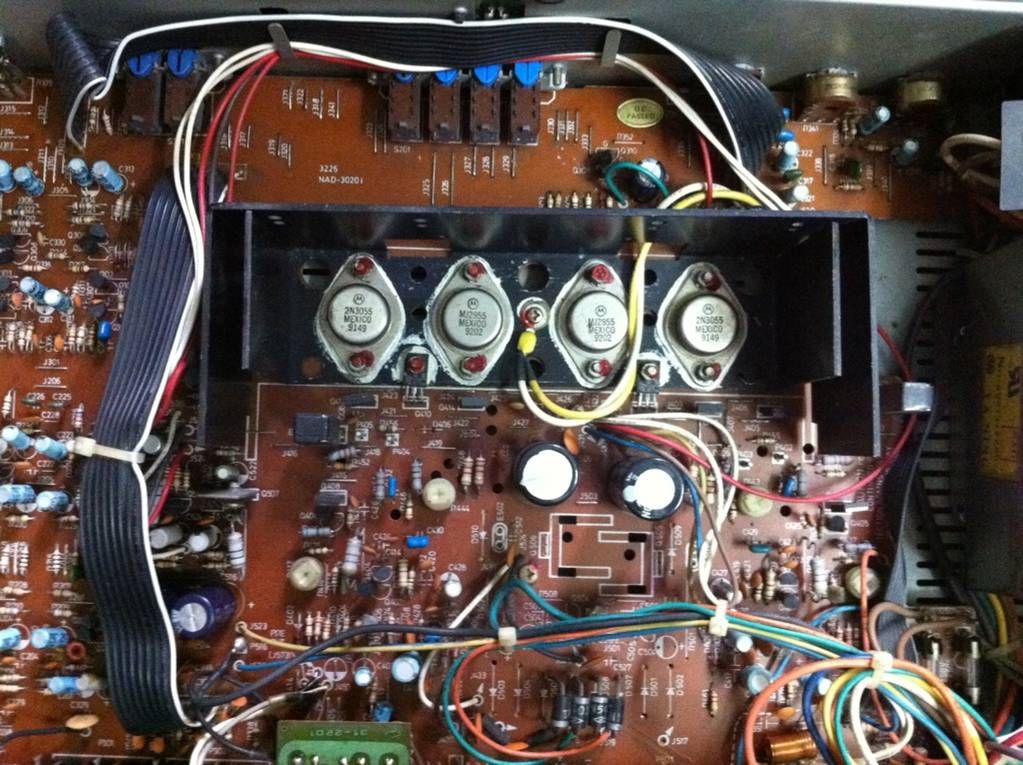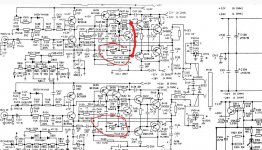Hi folks - looking for a bit of advice on this old NAD 3020i.
I can’t find any schematics that include information on the thermistor that was attached to the heatsink - I’ve been through every one I can find. I assume it’s a thermistor as the code on the PCB is THP.
There are few extra components related to the ‘thermistor’ on this version of the PCB too including and extra capacitor and transistor - R537 and Q517.
This is my first sticking point in getting the amp up and running again. 3 of the 4 big transistors weren’t working but that’s for another thread.
This amps too good to bin so determined to get it working again.
SO - is this likely to be a thermistor and what can I replace it with?
Any input is GREATLY appreciated.
Cheers
I can’t find any schematics that include information on the thermistor that was attached to the heatsink - I’ve been through every one I can find. I assume it’s a thermistor as the code on the PCB is THP.
There are few extra components related to the ‘thermistor’ on this version of the PCB too including and extra capacitor and transistor - R537 and Q517.
This is my first sticking point in getting the amp up and running again. 3 of the 4 big transistors weren’t working but that’s for another thread.
This amps too good to bin so determined to get it working again.
SO - is this likely to be a thermistor and what can I replace it with?
Any input is GREATLY appreciated.
Cheers
Last edited:
Quite likely yes, but we would have to see the circuit details to see how it is configured.
(Its pretty unusual for a small thermistor to be faulty)
(Its pretty unusual for a small thermistor to be faulty)
It wasn't faulty as such - the wires broke off and it was sealed in a small bead that was screwed to the heatsink. The bead broke while trying to expose something to solder on to. Can't find any info anywhere about it - never mind a circuit diagram! 😱)
Oh dear. I suspect you might have problems coming up with a replacement for that.
You need a circuit diagram to see how its configured. It should be possible to come up with a different bias arrangement not using a thermistor but we can't even think about that without knowing the circuit details.
You need a circuit diagram to see how its configured. It should be possible to come up with a different bias arrangement not using a thermistor but we can't even think about that without knowing the circuit details.
Presume you've looked here http://akdatabase.org/AKview/albums/userpics/10007/NAD 3020i 3225PE Service Manual.pdf
Yup - been through everything 🙁 I've only found one other person even mention it. They said they'd replaced it but failed to say what with.
Oh dear. I suspect you might have problems coming up with a replacement for that.
You need a circuit diagram to see how its configured. It should be possible to come up with a different bias arrangement not using a thermistor but we can't even think about that without knowing the circuit details.
Being totally ignorant about thermistors I initially thought this might just be a thermal fuse. What are the repercussions of shorting it out and having it on all the time? Magic smoke?
p.s. I guess I can cancel my RS spare parts order then?
It depends how it is configured and what type of thermistor it is as to whether shorting it is a temporary option.
A thermistor is a resistor that changes value in response to temperature change and that change can be used to stabilise the amplifier bias current over the full operating temperature range the amp might see.
Some thermistors are of a type that increase value with heat, and some reduce with heat. That's one problem. The other is how it acts on the circuit.
I could pretty much guarantee that if you shorted the 'base' of the two driver transistors together then that would force a low bias state and the amp would operate normally but with some residual crossover distortion.
You need to be familiar with what you are doing and looking at to do that though.
From there and getting the amp working we could look at replacing the thermistor and associated components with something that would take their place.
A thermistor is a resistor that changes value in response to temperature change and that change can be used to stabilise the amplifier bias current over the full operating temperature range the amp might see.
Some thermistors are of a type that increase value with heat, and some reduce with heat. That's one problem. The other is how it acts on the circuit.
I could pretty much guarantee that if you shorted the 'base' of the two driver transistors together then that would force a low bias state and the amp would operate normally but with some residual crossover distortion.
You need to be familiar with what you are doing and looking at to do that though.
From there and getting the amp working we could look at replacing the thermistor and associated components with something that would take their place.
Right then - I'm looking at that scenario as quite positive! 🙂
If there's no immediate consequences to shorting it out (just powering up for test purposes) then I'll change out the blown transistors and see if that's all that was wrong with it in the first place. I need to start a NAD 3020i transistor thread now...
If there's no immediate consequences to shorting it out (just powering up for test purposes) then I'll change out the blown transistors and see if that's all that was wrong with it in the first place. I need to start a NAD 3020i transistor thread now...
I didn't say you could short the thermistor, I said you could short out between the base of the two drivers. That's Q411 and Q413 here.
The red link shows the idea and most amplifiers are of this configuration (ignore the red circle).
Your thermistor may act in conjunction with a transistor (Q409 in this diagram) or it may act alone directly on the driver transistors. That is why we need the circuit details.
Also be sure to use a bulb tester when powering up to save any damage and blown parts. Its invaluable.
Have to leave it for today... don't blow it up 😉
The red link shows the idea and most amplifiers are of this configuration (ignore the red circle).
Your thermistor may act in conjunction with a transistor (Q409 in this diagram) or it may act alone directly on the driver transistors. That is why we need the circuit details.
Also be sure to use a bulb tester when powering up to save any damage and blown parts. Its invaluable.
Have to leave it for today... don't blow it up 😉
Attachments
Thanks for the input. Much appreciated! I'll try and get a diagram together of how this PCB differs from the 'normal' one and take it form there...
I do not see it on the NAD 3020i, NAD 3225PE service manual post at BadCaps.net
It might be one of those bias "varistors" the Japanese used for a while.
STV-4H AND STV-3H diodes array
It might be one of those bias "varistors" the Japanese used for a while.
STV-4H AND STV-3H diodes array
Found a photo of the pesky yellow thing on a Japanese (I think) website. Offending item is centre of photo.
.
URL of original site here

.
URL of original site here

By the newish looking layout of the wiring and the fact that a thermistor is neither listed or illustrated as attached to the heatsink or anywhere else in the 3020i manual(s), this has to be an afterthought or modification that isn't documented. For example, you mentioned R537 ....well where is this particular part and is there an issue/ID number of the main PCB that identifies the board as specifically 3020i or 3225pe?
What you could do, is trace the relevant part of circuit properly. Its not exactly difficult to follow the wires to circuit nodes where other components connect and so on until you find component numbers that are identifiable on the chematic and parts lists. Draw what you find and then anyone else reading can begin to follow the function and estimate the requirements of any thermistor.
What you could do, is trace the relevant part of circuit properly. Its not exactly difficult to follow the wires to circuit nodes where other components connect and so on until you find component numbers that are identifiable on the chematic and parts lists. Draw what you find and then anyone else reading can begin to follow the function and estimate the requirements of any thermistor.
Maybe this version of the amp uses one of those "diode of death" VD1212 that plagued so many Sony amps of that era.
Cheers
Cheers
Looking at where the part is, i would say it is not related to biasing, but rather that it's some sort of over-heat cutout
- Status
- Not open for further replies.
- Home
- Amplifiers
- Solid State
- NAD 3020i thermistor? Has anyone even seen this before?

